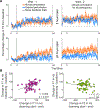Probing sensorimotor memory through the human speech-audiomotor system
- PMID: 39740348
- PMCID: PMC12172692
- DOI: 10.1152/jn.00337.2024
Probing sensorimotor memory through the human speech-audiomotor system
Abstract
Our knowledge of human sensorimotor learning and memory is predominantly based on the visuospatial workspace and limb movements. Humans also have a remarkable ability to produce and perceive speech sounds. We asked whether the human speech-auditory system could serve as a model to characterize the retention of sensorimotor memory in a workspace that is functionally independent of the visuospatial one. Using adaptation to altered auditory feedback, we investigated the durability of a newly acquired speech-acoustical memory (8- and 24-h delay), its sensitivity to the manner of acquisition (abrupt vs. gradual perturbation), and factors affecting memory retrieval. We observed extensive retention of learning (∼70%) but found no evidence for offline gains. The speech-acoustical memory was insensitive to the manner of its acquisition. To assess factors affecting memory retrieval, tests were first done in the absence of auditory feedback (with masking noise). Under these conditions, it appeared there was no memory for prior learning as if after an overnight delay, speakers had returned to their habitual speech production modes. However, when speech was reintroduced, resulting in speech error feedback, speakers returned immediately to their fully adapted state. This rapid switch shows that the two modes of speech production (adapted and habitual) can coexist in parallel in sensorimotor memory. The findings demonstrate extensive persistence of speech-acoustical memory and reveal context-specific memory retrieval processes in speech-motor learning. We conclude that the human speech-auditory system can be used to characterize sensorimotor memory in a workspace that is distinct from the visuospatial workspace.NEW & NOTEWORTHY There is extensive retention of speech-motor learning. Two parallel modes exist in speech motor memory, one with access to everyday habitual speech and the other with access to newly learned speech-acoustical maps. The availability of speech error feedback triggers a switch between these two modes. Properties of sensorimotor memory in the human speech-auditory system are behaviorally similar to, but functionally independent of, their visuospatial counterparts.
Keywords: auditory perception; contextual memory retrieval; implicit adaptation; speech memory retention; speech motor learning.
Copyright © 2025 The Authors.
Conflict of interest statement
Figures




References
-
- Yadav T, Tellez OM, Francis JT. Reward-dependent Graded Suppression of Sensorimotor Beta-band Local Field Potentials During an Arm Reaching Task in NHP. In: Proceedings of the Annual International Conference of the IEEE Engineering in Medicine and Biology Society, EMBS. Institute of Electrical and Electronics Engineers Inc., 2022, p. 3123–3126. - PubMed
MeSH terms
Grants and funding
LinkOut - more resources
Full Text Sources
Medical

